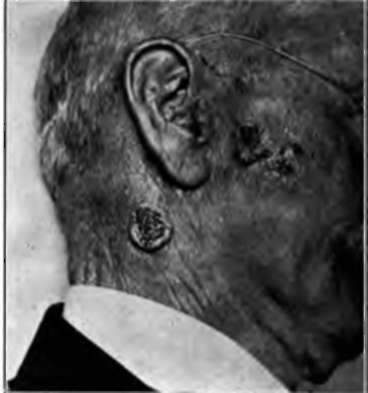IV. Depressed Scar-Like Cancer
Description
This section is from the book "Skin Cancer", by Henry H. Hazen, A.B., M.D.. Also available from Amazon: Skin Cancer.
IV. Depressed Scar-Like Cancer
Clinical Course
The depressed scar-like cancers are comparatively infrequent, the author's series containing but one case. As they start as a very small subepidermal nodule and as the skin over them remains intact, they frequently remain undiscovered for some little time. They usually arise upon the cheeks or temples of those well past middle life. The nodule flattens out, and slowly spreads along the basal layer of the rete, or just beneath it, and as a result the appearance is identical with that of a depressed scar, except that the color is not so white, and that the normal lines of the skin are to some extent retained. While the skin is thinner than usual, yet to examination it simply looks sunken and feels bound down, just as morphea patches do. There is no dilatation of the surface blood vessels. The induration can be plainly distinguished, feeling somewhat like a small coin imbedded beneath the skin.

Fig. 28.-This rolled-edge rodent ulcer of the neck has no ulceration, but is covered with a crust. (Heldlngsfeld's collection).
These neoplasms grow very slowly, and ulceration docs not take place until several years have elapsed. It is highly probable that tumors of this type may end in the morphea-like cancer shortly to be described.
Pathology
The histopathology is the same as in the preceding group.
Diagnosis
The differential diagnosis must be made from depressed scars, and from morphea.
Continue to:
Tags
bookdome.com, books, online, free, old, antique, new, read, browse, download
